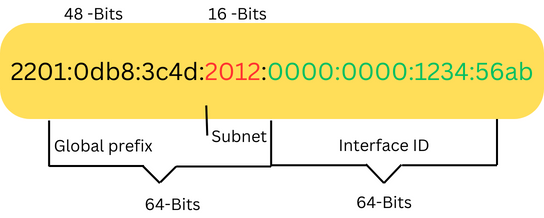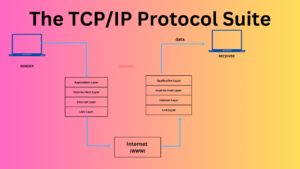Introduction
In both internet and local network environments, every device relies on its unique IP address for identification and communication. The IP address serves as a critical identifier, guiding data packets to their intended destinations across networks of varying scales.
In the realm of IPv6 networks, where scalability and efficiency are paramount, the IPv6 address plays a central role. Unlike its IPv4 counterpart, the IPv6 address is a 128-bit alphanumeric value, offering an expansive pool of unique addresses. This abundance not only ensures that every device can be uniquely identified but also facilitates efficient routing, enhancing network performance and reliability.
In summary, the IPv6 address stands as a testament to the evolution of networking technology, providing both a vast address space and optimized routing capabilities to support the ever-growing ecosystem of internet-connected devices.
Table of Contents
What is an IPv6 Address?
IP addresses serve as crucial identifiers facilitating communication among devices within a network. They play a vital role in distinguishing computers, routers, and webpages on the internet, enabling the seamless exchange of information across vast digital landscapes.
The advent of IPv6 addresses was prompted by the limitations and eventual exhaustion of IPv4 addresses. Unlike the 32-bit IPv4 protocol, IPv6 utilizes a 128-bit format, comprising eight groups of four alphanumeric characters each, separated by colons. This expanded address space provides an astonishing number of unique IP addresses—precisely 340,282,366,920,938,463,463,374,607,431,768,211,456. Such abundance ensures that the allocation of distinct IP addresses to new devices remains sustainable for the foreseeable future, alleviating concerns of address depletion.

Why Do We Need IPv6 Addressing?
The exhaustion of the 4.3 billion IPv4 TCP/IP address identifiers has driven the development of IPv6, primarily aimed at providing an ample supply of additional addresses. This fundamental enhancement makes IPv6 a pivotal advancement for the Internet of Things (IoT), addressing the burgeoning demand for connectivity among a vast array of devices.
IPv6 offers several key advantages that contribute to its significance in the IoT landscape:
- 1. Scalability: With its 128-bit addressing scheme, IPv6 provides an unprecedented abundance of unique IP addresses, ensuring scalability to accommodate the proliferation of IoT devices. This scalability is essential for seamlessly integrating countless interconnected devices into networks of varying sizes.
- 2 . Security: IPv6 incorporates built-in security features, such as IPsec (Internet Protocol Security), which enhances data confidentiality, integrity, and authentication. These robust security mechanisms are crucial for safeguarding sensitive information transmitted between IoT devices and networks.
- 3. Connectability: IPv6’s expansive address space and efficient routing capabilities facilitate seamless connectivity among IoT devices, regardless of their location or network infrastructure. This ensures uninterrupted communication and enables the interoperability of diverse IoT ecosystems.
Types of IPv6 Addresses
IPv6 offers three distinct types of addressing methods:
- 1. Unicast Address: This address type is used to identify a single network interface. A packet directed to a unicast address is sent specifically to the interface associated with that address.
- 2. Multicast Address: Multicast addresses are used to send packets to a group of hosts that share a common interest. These hosts can be located across different geographic locations. Any interface belonging to the multicast group will receive packets sent to this multicast address.
- 3. Anycast Address: Anycast addresses are assigned to a group of interfaces, typically distributed among multiple routers. When a packet is sent to an anycast address, it is delivered to the nearest interface that also possesses that anycast address. The routing protocol determines which interface is considered the closest for packet delivery.
Note: A network interface represents the point of connection between a computer and a private or public network. It may not always be a physical network interface card (NIC) and can be implemented as software. For example, the loopback interface (127.0.0.1 for IPv4 and ::1 for IPv6) simulates a network interface through software rather than a physical device.
What is the Format of the IPv6 address?
IPv6 addresses consist of 128 bits and are represented in hexadecimal format, with each 16-bit block translated into a 4-digit hexadecimal integer, separated by colons. The format of an IPv6 address is structured as follows:
XXXX:XXXX:XXXX:XXXX:XXXX:XXXX:XXXX:XXXX, in which each “X” represents four bits in hexadecimal notation. This notation covers the entire range of IPv6 addresses, from 0000:0000:0000:0000:0000:0000:0000:0000 to ffff:ffff:ffff:ffff:ffff:ffff:ffff:ffff.
An IPv6 address is composed of two main components: the network component and the node component. The first 64 bits of the address, known as the network component, are utilized for routing purposes. The remaining 64 bits, known as the node component, specify the address of the interface.
The network node can be further divided into a block of 48 bits and a block of 16 bits. The upper 48 bits are typically reserved for global network addresses, facilitating routing across the internet. The lower 16 bits are commonly used for subnetting within internal networks, allowing network administrators to manage and organize subnets efficiently.

Advantages of IPv6 Address
IPv6 brings several advancements that enhance network performance, efficiency, and security:
- Efficient Routing: IPv6 introduces streamlined and hierarchical routing, reducing the size of routing tables. Unlike IPv4, where routers handle fragmentation, in IPv6, the source device manages fragmentation using a protocol to detect the maximum transmission unit along the path.
- Efficient Packet Processing: IPv6 eliminates the need for routers to regenerate the checksum at each hop, as IPv4 does. This optimization simplifies packet processing and reduces processing overhead.
- Directed Data Flows: IPv6 supports multicast, allowing packets to be simultaneously sent to multiple destinations without the need for broadcast. This conserves network bandwidth, especially for packet flows that require significant bandwidth.
- Security: IPv6 incorporates IPSec (Internet Protocol Security) as a fundamental component, providing robust data integrity, confidentiality, and authentication. IPSec ensures that communication over IPv6 networks is secure and protected from unauthorized access or tampering.
Overall, these features make IPv6 a significant improvement over IPv4, offering enhanced efficiency, scalability, and security for modern network environments.
Disadvantages of IPv6 Address
- 1. Increased Routing Table Entries: The extensive number of IPv6 networks can strain network infrastructure, leading to an overload of routing table entries. This can result in inefficiencies and potential bottlenecks in routing operations.
- 2. Compatibility Issues with Older Devices: Older devices that lack support for IPv6 require manual configuration using dual-stack approaches, which implement both IPv4 and IPv6 protocols. This adds complexity and additional effort for network administrators, especially in environments with a mix of legacy and modern devices.
- 3. Slow Global Adoption: Despite the advantages of IPv6, its adoption has been sluggish on a global scale. IPv4 continues to be widely used, and the transition to IPv6 has been slow. This reluctance to switch to IPv6 can be attributed to various factors, including compatibility concerns, cost implications, and the inertia of established IPv4 infrastructure.
Addressing these disadvantages requires concerted efforts from various stakeholders, including network operators, device manufacturers, and policymakers, to overcome compatibility issues, promote IPv6 deployment, and facilitate a smooth transition from IPv4 to IPv6.
FAQs
Q: How long is an IPv6 address?
A: IPv6 addresses consist of 128 bits and are represented by a series of hexadecimal numbers. Each hexadecimal digit represents four bits, resulting in a total of 32 hexadecimal values.
Q: What is the address size of IPv6?
A: IPv6 addresses are 128 bits in size.
Q: What are valid IPv6 link local unicast addresses?
A: In IPv6, the address block fe80::/10 is reserved for link-local unicast addressing.
Conclusion
In conclusion, IPv6 offers numerous advantages in terms of speed, efficiency, and reliability. However, the transition from IPv4 to IPv6 is an ongoing process that will take time to complete. Despite the challenges, IPv6 is undoubtedly the future of networking, especially considering the significant increase in the number of users over the past decade.
One of the key benefits of IPv6 is its enhanced security features, which make it a more secure method for information transfer compared to IPv4. Additionally, IPv6 addresses many of the limitations of IPv4 and introduces additional capabilities and functionalities that simplify network administration tasks.
Overall, while the adoption of IPv6 may require patience and effort, its benefits in terms of performance, security, and scalability make it a crucial advancement in the evolution of networking technology.



